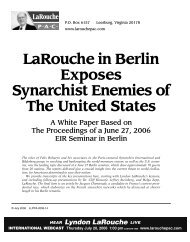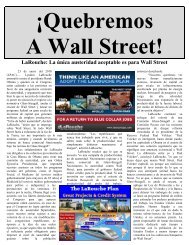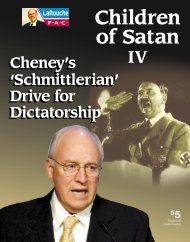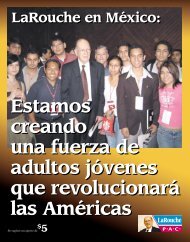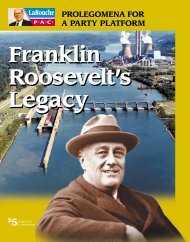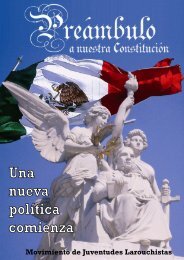Spoon-Benders - LaRouche - LaRouchePAC
Spoon-Benders - LaRouche - LaRouchePAC
Spoon-Benders - LaRouche - LaRouchePAC
Create successful ePaper yourself
Turn your PDF publications into a flip-book with our unique Google optimized e-Paper software.
The terrorist acts some officers considered as ‘pretexts to justify’ U.S.<br />
invasion of Cuba.<br />
Force, and the author was Gen. Edward Lansdale, the<br />
CIA’s top counterinsugency expert, who was then posted<br />
to the Office of Special Operations in the Pentagon,<br />
and who had just drafted the curriculum for the Army’s<br />
newly established Special Warfare Center at Fort<br />
Bragg.<br />
It is well known that the Cuba Task Force was plotting<br />
the assassination of Cuba’s Fidel Castro. What was not<br />
known until a few years ago, was that, during 1962, the<br />
Cuba Task Force was also proposing to carry out acts of<br />
terrorism against the United States, to be blamed on Cuba,<br />
for the purpose of dragging the United States into a war<br />
against Cuba.<br />
The 1962 terrorism plan was called “Operation<br />
Northwoods,” and it was issued under the signature of<br />
Joint Chiefs of Staff chairman Lyman Lemnitzer. But it<br />
appears to have been drafted by Lansdale and his team<br />
on the Cuba Task Force, and then presented to Lemnitzer<br />
for his signature, so that he would then present it to<br />
Secretary of Defense Robert McNamara. (In April 2001,<br />
16<br />
McNamara denied ever having heard of the<br />
“Northwoods” plan.)<br />
The cover memorandum stated that the Joint<br />
Chiefs of Staff “have considered” the attached<br />
memorandum, which is a “description of pretexts<br />
which would provide justification for military<br />
intervention in Cuba.”<br />
The attached memorandum stated that it is<br />
assumed that a political decision for a U.S.<br />
military intervention “will result from a period<br />
of heightened U.S.-Cuban tensions which<br />
place the United States in the position of suffering<br />
justifiable grievances.” It contains a<br />
series of proposals for actions which would<br />
be used to provide an excuse for military<br />
intervention.<br />
The first proposal was for “a series of wellcoordinated<br />
incidents” to take place in and<br />
around the U.S. Navy base at Guantanamo Bay,<br />
Cuba; these were to include having friendly<br />
Cubans dress in Cuban military uniforms to start<br />
riots at the base, to blow up ammunition inside<br />
the base, to start fires, to burn aircraft on the air<br />
base, to sabotage a ship in the harbor, and to<br />
sink a ship near the harbor entrance.<br />
The next: “A ‘Remember the Maine’ incident<br />
could be arranged. . . . We could blow up a U.S.<br />
ship in Guantanamo Bay and blame Cuba,” or<br />
blow up a drone ship in Cuban waters. The<br />
memorandum coldly predicted: “Casualty lists in<br />
U.S. newspapers would cause a helpful wave of<br />
national indignation.”<br />
The memorandum continued: “We could<br />
develop a Communist Cuba terror campaign in<br />
the Miami area, in other Florida cities and even<br />
in Washington. . . . We could sink a boatload of<br />
Cubans en route to Florida (real or simulated).<br />
We could foster attempts on the lives of Cuban<br />
refugees in the United States. . . .<br />
“Exploding a few plastic bombs in carefully chosen<br />
spots, the arrests of Cuban agents and the release of<br />
prepared documents also would be helpful.”<br />
Among other actions proposed were to use fake Soviet<br />
MiG aircraft to harass civil aircraft, to attack surface shipping,<br />
and to destroy U.S. military drone aircraft.<br />
“Hijacking attempts against civil air and surface craft”<br />
were also suggested, and then—the most elaborated plan<br />
of all—to simulate the shooting down of a chartered civil<br />
airliner in Cuban airspace.<br />
President Kennedy rejected the plan, and the military<br />
directed that all the pertinent documents be destroyed.<br />
Nevertheless, some of the documents did survive, and,<br />
hidden by heavy classification for decades, they only came<br />
to light in recent years.<br />
The above is adapted from “The Enigma of the Fulbright<br />
Memorandum,” published in the Oct. 12, 2001 issue of<br />
EIR magazine and later updated for the “Zbigniew<br />
Bzrezinski and September 11” <strong>LaRouche</strong> in 2004 Special<br />
Report.





